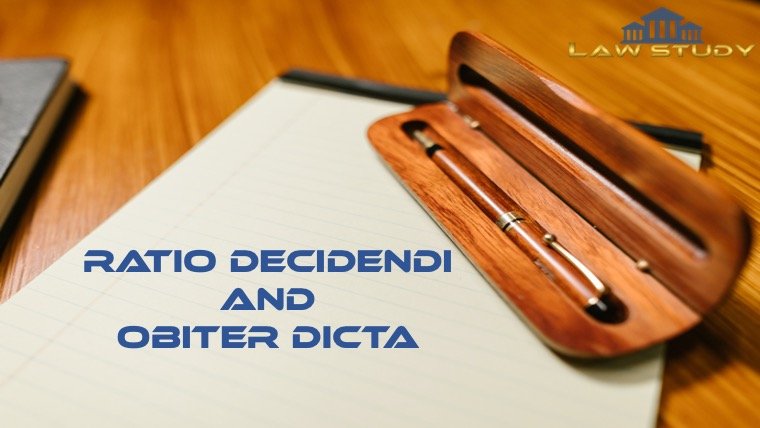Introduction of the Ratio Decidendi and Obiter Dicta with Case Laws: This term refers to the factors that influence a court’s decision. The decision-making ratio is binding as a precedent and is the biggest part of the case in judgment. The statements of law are the only ones that are legally binding. This is known as a judgment reason or reason for a decision. The rest of the justifications are merely “by the way” or obiter dictum.
Worsley rondel v. If the former “per incuriam” turns out to be inadequate, the case does not bind the court. For example, a case is not binding if no official provisions or exact cases have been previously submitted to the court prior to the judgment. Furthermore, if a court determines a material difference among cases, it can decide that it is not bound by the previous case. These are persuasive, but they aren’t appealing. More crucially, higher court decisions or government policy may overturn earlier decisions.
Meaning of the Ratio Decidendi
“Ratio decidendi” is a Latin phrase that means “reason” or “justification for a choice.” The ratio decidendi is defined as “the aspect of a case that determines the judgement” or the concept exemplified by the case.” “The research proves the point.” To put it another way, a legal term evolved from it is ratio decidendi, which denotes the area in which a decision is made of law analysis in a verdict that influences the case’s outcome being coherent/consistent. It’s a term that relates to a court’s legal, ethical, political, and ethical concerns when making a decision.
Goodhart’s perspective on ratio decidendi
On the other hand, did not accept the above-mentioned classical definitions. His criticisms were as follows:
- Even if the judge does not express an opinion, every case must contain an ascertainable legal principle.
- That the legal statement may be too broad or too narrow.
“The whole premise of my article was founded on ideas that each case should contain a binding principle, but that this binding executive is not necessarily present in the judge’s declaration of law,” he added as he defended his interpretation.
It also said, “The magistrates have to interpret statues but that they are building them is misleading to say.”
He even stated that “the sentence ‘ratio decidendi’ was misleading because the decision of the judge was not binding and could not represent the principal in an exact manner.”
He proposed that determining the ‘principle of the case’ would help.
The judge considers the facts as material, and his decision is based on them. The judge therefore expresses his or her own views on the facts. If we consider a case, our goal is to describe the facts the judge notes and the findings that the court reaches on the basis of them. The judge creates legislation by deciding the material facts.
Goodhart therefore emphasized the material fact, as the judge views it, rather than the material facts as someone else perceives them.

A component of a ruling that is pertinent to the facts and circumstances of a case. Judges take into account social conditions, morality, and natural justice principles, which is why they play such an important part in the evolution of the legal system.
Obiter Dicta is divided into two categories
- If a statement of law is founded on facts that were either not determined to be material or did not exist at all, it is considered obiter dicta.
- Even if a declaration of law is founded on the facts, if it is not based on the decisions, it would be considered as obiter. An obvious example is a legal statement issued in support of a dissenting judgment.
Although obiter dicta do not have legal authority, they can have a powerful persuasive effect.
landmark cases
Krishna Kumar & another. v. Union of India
The ratio of decision-making shall be determined by examining the facts of the case, and by a deducted process involving the pre-existing, statutory, or judged rule of law and the minor premise, which are the important facts of the case under consideration. If something is unclear, it is not the court’s responsibility to explain it in great detail in order to be bound by it. We therefore conclude that the relationship is a precedent to be observed. The obiter dictum is the other important element of a decision.
Orissa State v. Sudhanshu Mishra
A judgment such as Orissa State v. Sudhanshu Mishra is solely responsible for what it decides in fact. What concerns is the ratio of decision, not all observations discovered within, nor the logical consequence of several remarks stated therein.
The Punjab of state v. Dalveer Singh
Even though the circumstances directly related to an earlier case are the same as the case before the court, the judge is not obliged to draw the same conclusions from the earlier decision.
Fazlunbi v. K.Khader Vali & another
Supreme Court precedents should not be ignored. They could not be dismissed by claiming that precedents are only authoritative “on its actual facts”. Such devices shall not be permitted to the High Court when decisions of the Supreme Court are referred to it, not only for the preceding case law but also for the imperatives of Article 141.
Antulay c. RS Nayak & Others
In ignorance of the contradictory legislative provision or legal authority binding on the Court, In Antulay c. RS Nayak & Others per-incuriam In such a way that part of the decision or reasoning upon which it is based is clearly incorrect, The court has the authority to overlook a decision made per incuriam.
Arnit Das v. Bihar State
A judgment not expressed and not accompanied by reasoning cannot be considered a law declared binding by the law as intended by Article 141 based on deliberate analysis of the issue. If a particular legal issue has not been resolved consciously, the judgment has not escaped in the technical sense (this is the rule of sub- silentio).
The distinction between Ratio decidendi & obiter dicta
| Ratio Decidendi | Obiter Dicta | |
| Definition | When a judge makes a decision, they rely on the ratio decidendi. This is their conclusion on a legal question, not just a repetition of the law. | Obiter dicta are legal thoughts or remarks made by judges that don’t affect the outcome of the case. |
| Role | Ratio decidendi refers to a legal standard that the judge either explicitly or implicitly considers as a vital factor in reaching their decision. | Obiter dictum is a legal stance adopted by a judge that wasn’t explicitly or implicitly deemed necessary for obtaining their judgment. |
| Fundamental aspect | The judge is applying the law to the specifics of the case, rather than merely stating it. | The judge’s decision in this case does not rely on the legal explanation or rationale provided. |
| Significance | The provided explanation is necessary to determine the outcome of the case. | The aforementioned legal statement or argument is hypothetical and is solely employed for illustration or clarification purposes. |
| Authority | The ratio decidendi is binding and holds authoritative power over inferior courts. | An obiter dictum carries no such weight. It is a phrase by the courts that has no weight. |

























